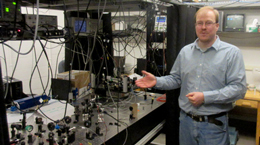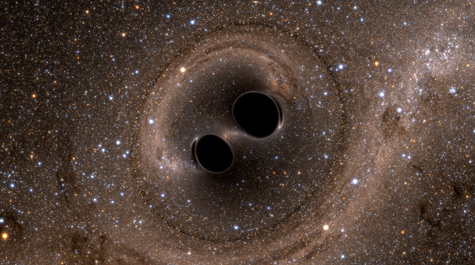4 William & Mary scientists were part of Nobel-winning LIGO observation
Three leaders of the LIGO collaboration’s Sept. 14, 2015, observation of gravitational waves shared the 2017 Nobel Prize in Physics. A number of William & Mary scientists were participants in the LIGO experiment, but will not share in the honors.
The Nobel laureates, announced Oct. 3 by the Royal Swedish Academy of Sciences, are Rainer Weiss, Kip S. Thorne and Barry C. Barish. All three are members of the Laser Interferometer Gravitational-Wave observatory.
Four William & Mary physicists were involved in the same collaboration, which recorded gravitational waves resulting from the merging of two black holes 1.3 billion years ago. The William & Mary collaborators — all co-authors on the paper published in the journal Physical Review Letters — were led by Eugeniy Mikhailov, an assistant professor in the university’s Department of Physics. Other LIGO participants were Mi Zhang and Gleb Romanov, who both received Ph.D.s from the department in 2017, and an undergraduate physics student, Hunter Rew ’16.
Mikhailov’s group joined the LIGO Scientific Collaboration (LSC) in 2012. William & Mary is the only Virginia university to participate in the LSC, which includes more than 1,000 members. Despite the large number of scientists involved, Nobel rules limit the number of recipients for a single prize to three.
 The statutes of the Nobel Foundation are specific on this point: “In no case may a prize amount be divided between more than three persons.” The regulations preclude a prize being awarded to participants of the multi-scientist breakthroughs that have become increasingly common. One of the LIGO laureates lamented the situation.
The statutes of the Nobel Foundation are specific on this point: “In no case may a prize amount be divided between more than three persons.” The regulations preclude a prize being awarded to participants of the multi-scientist breakthroughs that have become increasingly common. One of the LIGO laureates lamented the situation.
“We live in an era where some huge discoveries are really the result of giant collaborations, with major contributions coming from very large numbers of people,” Thorne told Adam Smith, chief scientific officer of Nobel Media, in a telephone interview. “I hope that in the future the Nobel Prize committee finds a way to award the prize to the large collaborations that make this and not just to the people who may have been seminal to the beginning of the project, as we were.”
Mikhailov acknowledges that if the committee awarded the Nobel Prize to the work itself, as opposed to individuals, he and all the other William & Mary participants would be laureates, but he is philosophical about the situation.
“I’m delighted that the LIGO experiment won the prize,” he said. “We all were a part of it. But really, I was not in the observatory at the time.”
He added that he understood that the Royal Swedish Academy is bound by the wishes of Alfred Nobel and those that established the framework for the annual awards before large, multinational collaborations became the norm. The nature of such collaborations in the internet age allows scientists to work together on a project without ever meeting each other in person.
“It’s like many things in society,” he said. “There are people who work on different aspects of jobs. They don’t necessarily need to meet.”
The press release announcing the awards acknowledged the collaborative nature of the discovery, which verified a long-standing prediction by Albert Einstein, one that Einstein himself doubted could ever be proven.
“LIGO, the Laser Interferometer Gravitational-Wave Observatory, is a collaborative project with over one thousand researchers from more than twenty countries. Together, they have realised a vision that is almost fifty years old,” the release states.
The 2015 LIGO observation opened a new age in gravitational-wave astronomy and was bolstered by a 2017 detection of another passing of gravitational waves detected by the two LIGO interferometers in Washington state and Louisiana, as well as the VIRGO detector in Europe.















